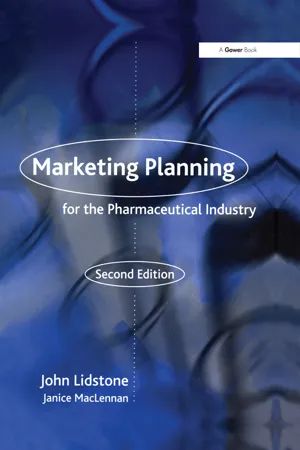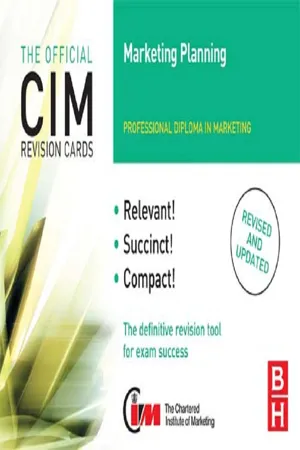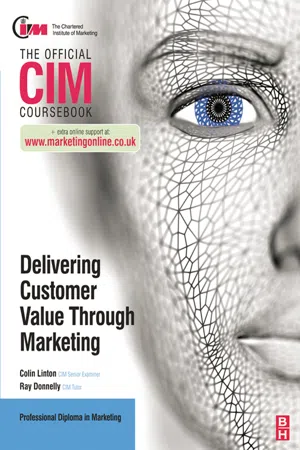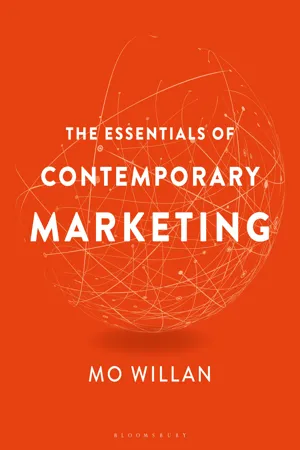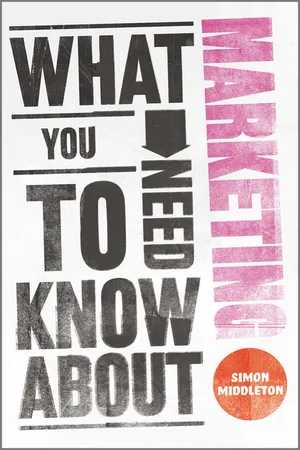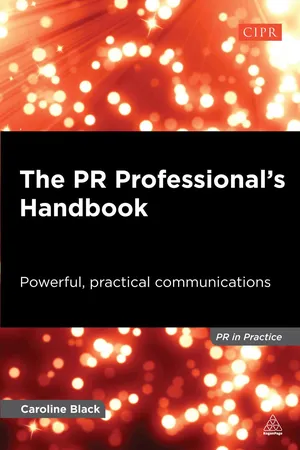Promotional Mix
The promotional mix refers to the combination of promotional tools and strategies used by a company to communicate with its target audience and achieve its marketing objectives. It typically includes advertising, sales promotion, public relations, direct marketing, and personal selling. By utilizing a mix of these promotional elements, companies can effectively reach and influence their customers.
8 Key excerpts on "Promotional Mix"
- John Lidstone, Janice MacLennan(Authors)
- 2017(Publication Date)
- Routledge(Publisher)
...Generally, there is increasing recognition that one should not be tied to the traditional mix, but rather should use whatever contact methods offer the best way of delivering the message to the target audience(s). In conclusion, decisions need to be made with regard to the most effective communications style, media, and tools, to deliver the communication objectives to the target audience. Accurately broadcasting the right message to the correct constituency at the right time is critical to the success of any product, however large or small it is. Thus, there is a need to understand how to manage each element of the Promotional Mix to achieve an effective communications strategy, and how to consider the other elements within the marketing mix in order to develop such a strategy. There is also a need to learn how to develop advertising objectives and strategies, a creative strategy, a media strategy, how to measure and test buyer response to marketing communications, and how to manage the relationship between the client and the agency. Finally, there is a need to understand current practices in advertising, sales promotion, public relations, and direct marketing and personal selling. This section addresses these issues. The Promotional Mix Each element of the Promotional Mix plays a distinctive role in a communications programme. Below is a summary of the role that each might play, the form that they might take, and their advantages. A successful communications strategy requires that one finds the right combination of promotional tools and techniques, defines their role and the extent to which they can or should be used, and co-ordinates their use...
- eBook - ePub
- Karen Beamish(Author)
- 2013(Publication Date)
- Routledge(Publisher)
...market Increasing product/service usage Reminding/reinforcing Reducing demand fluctuations Advertising and the marketing mix As a marketing communications planner you will be involved in the following: Liaising with channel members Have an awareness of channel needs and the associated communications support Provide consistency for all communications and ensure that all members are empowered by the message Sales Promotions Sales Promotions – A range of tactical marketing techniques, designed within a strategic marketing framework, to add value to a product or service in order to achieve specific sales and marketing objectives Aims and objectives of sales promotions To increase brand and product awareness To increase trial and adoption of products To attract customers to certain brands To level out fluctuations in supply and demand To disseminate information To encourage trading up to next size Sales promotions and the marketing mix Responsibility for sales promotions include: Selecting appropriate promotional techniques Trade promotions, retailer to consumer promotions, manufacturer to consumer promotions Development of customer loyalty schemes Public Relations Public relations – is a planned and sustained effort to establish and maintain goodwill and mutual understanding between an organization and its target...
- eBook - ePub
- Chris Fill, Graham Hughes(Authors)
- 2012(Publication Date)
- Routledge(Publisher)
...Most advertising campaigns will be supported with sales promotions activities or PR, or both. A direct mail campaign may follow media activity designed to stimulate interest in the product. Most companies use point-of-purchase material to remind the consumer of their advertising message at the point where purchase decisions are made. A recent yet long-running car campaign included, among other things, a major television, print and poster advertising, PR activity resulting in major articles in the national press about both the car and the advertising, dealer support activity, exhibitions, sponsorship and direct mail. What is important, and vitally so, is that each element of the communications mix should co-ordinate with the other elements in the mix in order to achieve the communication of a single and unified message. Clearly, the impact of the message will be enhanced if it is reinforced by other parts of the mix, and the campaign objectives will be achieved in a more cost-effective manner. Activity 2.4 Find examples of each of the elements of the marketing communications mix used by two directly competing organizations. Are there any differences between how the elements are being used by the two organizations? Marketing communications is an essential part of the marketing mix – sometimes described as the ‘Four Ps’ – with the communications aspect represented by P for promotion. It is important to understand that each of the elements interacts with each of the others. Thus, the nature of the product – and its appeal to the customer – will be influenced by the price which is charged. Similarly, the availability of the product at specific retail outlets and through different dealerships may influence a customer’s perception of the quality of the product...
- Ray Donnelly, Colin Linton, Colin Linton(Authors)
- 2010(Publication Date)
- Routledge(Publisher)
...As Fill (2006) suggests permission marketing sows the seeds for a relationship which emanates from the audience and not the owner of the brand. Advertising is better for creating awareness and personal selling is more effective at promoting action and purchase behaviour. The increasing use of public relations and in particular publicity, is a refection of the high levels of credibility that this medium holds. In summary the five communication tools are: Advertising : mass media is often used to create awareness or encourage trialing of a product. Personal selling : common in retail or business-to-business market. Expensive, but often needed when complex products are involved. Sales promotion : used to encourage trial or increase usage – tactical and flexible. Public relations (including sponsorship) : PR is not paid for, but often requires agency involvement, which can be expensive. Direct marketing : Increasingly popular tool that can deliver personalised messages. Let’s look at these in turn. Advertising Yeshin (2006) defines advertising as ‘paid-for, non-personal communication from an identified organisation, body, or individual designed to communicate information and to influence customer behaviour. The range of advertising channels is huge and if an organisation operates internationally the choice is daunting...
- eBook - ePub
- Mo Willan(Author)
- 2021(Publication Date)
- Bloomsbury Business(Publisher)
...However, its benefits cannot be overestimated and it is undertaken to achieve the following objectives. The DRIPE Framework best explains the purpose of marketing promotions: D = Differentiate – the means of showing the uniqueness of the products promoted R = Remind – aim at existing or previous customers to keep the product fresh in their minds and tempt them to buy again I = Inform – aimed at prospective customers to convince them to buy the product P = Persuade – convince both existing and prospective customers to buy the product E = Engage – maintaining long-term relationships with customers The Promotions Mix The promotions mix refers to the tools, methods or techniques that marketers can use to promote the firm’s products. Figure 20: Marketing Communications and the Marketing Mix The Promotional Mix consists of six techniques/tools/methods: • Advertising • Sales promotions • Direct marketing • Personal selling • Public relations and • Sponsorship Advertising Advertising can be defined as ‘any paid-for form of non-personal communication effected through mass media by an identified sponsor’ (Bovee, 1992). The AIDA framework explains the objectives of advertising: A = Awareness I = Interest D = Desire A = Action Theories Of Advertising There are two theories of advertising, namely strong and weak theories. The strong theory is based on the premise that advertising can affect a degree of change in the knowledge, attitudes, beliefs or behaviours of target audiences. Exponents of this theory believe that advertising can persuade people to buy products that they have never previously purchased. The weak theory stresses that a consumer’s pattern of brand purchases is driven more by habit than exposure to promotional messages...
- eBook - ePub
Fashion Marketing and Communication
Theory and Practice Across the Fashion Industry
- Olga Mitterfellner(Author)
- 2019(Publication Date)
- Routledge(Publisher)
...The choice of promotional channels is part of the communications strategy planning that a business has to establish. This involves setting goals, budgets and measurable Key Performance Indicators (KPIs) to monitor the outcome of the communications endeavours. Promotion is also a question of cost because campaigns and appropriate channels can be very expensive. Equally, a well-planned and executed promotional activity by a brand can have high return-on-investment. Most brands cannot exist without promotional activities. Marketing communications tools The business strategy of any company will likely include overall objectives and the marketing department will make an appropriate marketing plan. This is then transferred onto an operational plan which describes how marketing communications should be executed. The marketing communications plan will make a time-frame in which the most appropriate tools will be implemented and how. In terms of the Marketing Mix, it is the P for Promotion. Figure 3.3 shows an approach to the Integrated Marketing Communications plan and the various tools available. Depending on the business needs, this can be reduced, expanded or changed to best fit the strategic and marketing goals and usually a combination of on-line and off-line measures is used, which can be classified into Above-the-Line and Below-the-Line activities. These are explained in more detail in Chapter 4 and consist of: Figure 3.3 Integrated Marketing Communications...
- eBook - ePub
- Simon Middleton(Author)
- 2012(Publication Date)
- Capstone(Publisher)
...CHAPTER 5 COMMUNICATING WHAT IT’S ALL ABOUT Promotion – where marketer and customer meet The difference between push and pull marketing Getting attention and prompting action Getting the right Promotional Mix The elements of marketing communications So far we have looked at the central importance of the customer, the necessity of developing products that people want and need, and the discipline of analysing the market environment and segmenting the market. But up to this point we have barely mentioned the part of marketing which to the outsider is often seen as the whole: promotion. THE SECOND ‘P’ Promotion is the second ‘P’ of marketing’s famous 4Ps model of the ‘marketing mix’ devised in 1960 by the influential Michigan University professor E. Jerome McCarthy (author the influential book Basic Marketing: A Managerial Approach which is still in print today). The other Ps are Product, which we have already examined, Place and Price, which we come to in the next chapter). Promotion in the sense we are using it here is rather broader in scope than it sounds. In fact many marketers refer instead to ‘marketing communications’ or the shorthand ‘marcomms’. The terms are synonymous. We will use ‘marketing communications’ simply because it is more broadly descriptive of the discipline: which involves the strategy and the process by which marketers communicate with audiences. THE MARKETING COMMUNICATIONS MIX Traditionally marketing communications falls into four broad disciplines, each of which plays a different role in the overall marcomms picture: Advertising; Public relations (popularly known as PR); Sales promotion; Personal selling. Since the dramatic rise of the internet the first three of these are just as likely to be carried out ‘online’ as in the offline world. But of course the digital age has done more than change emphasis, it has changed the rules...
- eBook - ePub
The PR Professional's Handbook
Powerful, Practical Communications
- Caroline Black(Author)
- 2014(Publication Date)
- Kogan Page(Publisher)
...(Adcock et al, 2001) There will always, one can assume, be a need for some selling. But the aim of marketing is to make selling superfluous. The aim of marketing is to know and understand the customer so well that the product or service fits him and sells itself… ideally, marketing should result in a customer who is ready to buy. All that should be needed then is to make the product or service available, ie, logistics rather than salesmanship, and statistical distribution rather than promotion. (Drucker, 2009) What is the marketing mix? In the early 1960s, Professor Neil Borden (Borden, 1964) at Harvard Business School in the United States identified a number of actions that can influence the consumer decision to purchase goods or services. Borden suggested that all those actions represented a ‘marketing mix’. Professor E Jerome McCarthy (McCarthy, 1960), also at the Harvard Business School in the early 1960s, suggested that the marketing mix contained four elements: product, price, place and promotion. In popular usage, ‘marketing’ is the promotion of products, especially advertising and branding. However, in professional usage the term has a wider meaning that recognizes that marketing is customer-centered. Services or products are often developed to meet the desires of groups of customers or even, in some cases, for specific customers. McCarthy divided marketing into four general sets of activities. His typology became so universally recognized that his ‘Four Ps’ became legendary: • P 1 Product –The product aspects of marketing deal with the specifications of the actual services or goods, and how they relate to the customer’s needs and wants. • P 2 Pricing – This refers to the process of setting a price for a service or product, including discounts...
